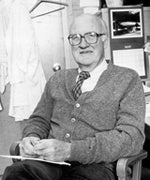Jeremiah “Jere” Mead, architect of the field of respiratory mechanics, had a 37-year career at Harvard School of Public Health that spanned an era of significant growth for the School. A Harvard College and Medical School graduate, Mead was known as a tinkerer who found fun in experimentation. He frequently built conceptual models out of household items, and embraced seemingly outlandish questions and hypotheses as the essential driving force of innovation. He realized his passion for research while engaged in cold-climate physiology experimentation during a post-war Army assignment at Fort Churchill, Manitoba, Canada, a field station for the Quartermaster Corps Climatic Research Laboratory (CRL).
Upon his return from service, Mead left clinical medicine and sought to build a career in the lab, which he found at HSPH. He began his career here in 1950 as an associate professor in physiology, rose to full professor in 1965, and was appointed the first Cecil K. and Philip Drinker Professor of Environmental Physiology in 1976.
Mead’s interest in decoding the normal mechanisms of breathing inspired the growth of the new field of respiratory mechanics, which continued to expand throughout the latter half of the twentieth century. He and his collaborators developed methods and instruments for measuring air flow and evaluating pulmonary function with ever-increasing accuracy. In recent decades these tools have been applied to the treatment and relief of patients suffering from a host of medical conditions including (but not limited to) poliomyelitis, cystic fibrosis, and asthma.
Perhaps his most recognized discovery came in the late ‘50s with then-research fellow Mary Ellen Avery. Mead and Avery showed that fatal respiratory distress syndrome in newborns was caused by abnormal surface tension in the lungs. Their discovery led to the development of surfactant replacement therapy, a treatment that continues to save newborn lives.
Mead retired in 1987, upon which occasion a fellowship named after him was established by the colleagues, trainees, and friends who were so inspired by him. He remained engaged with his field beyond retirement, up to his death in 2009.
This essay is adapted from one researched and written by Carolyn Damon Hayes, Project Archivist for Archives of Women in Medicine at Countway Library’s Center for the History of Medicine. You can read the original at the Center for History of Medicine’s blog.
* * * * *
Is there an event, person, or discovery in Harvard School of Public Health history that you’d like to read about? Send your suggestions to centennial@hsph.harvard.edu.
